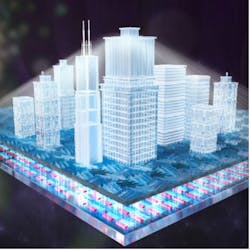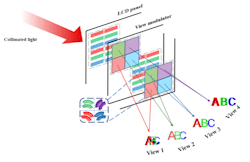Flat lens technique expands, enhances 3D displays
Light-field 3D displays traditionally offer a limited viewing range, prompting virtual images to degrade the further away from the device someone moves. But a system using newly developed flat lenses significantly expands that range, with a much larger depth of focus.
For decades, glasses-free 3D displays encountered formidable problems such as limited motion parallax, crosstalk, visual fatigue, and limited viewing distance. “The physical insight of a glasses-free 3D display is light manipulation and light-field reconstruction,” says Wen Qiao, a professor at Soochow University’s School of Optoelectronic Science and Engineering in Taiwan.
A new 3D light-field display system uses a dense field of light rays to produce real-time 3D videos in full color and without glasses. Realistic images are created when different views are projected, allowing a 3D scene to look the same as when viewed from different angles (see Fig. 1).
Development of a new flat lens helped the researchers overcome that challenge. Traditional geometric lenses operating in the visible spectrum have a focal depth on the order of about 1 mm. The new diffractive flat lens—created by patterning nanostructures onto a flat surface in a way that focuses light—touts a considerably extended focal depth based on multi-diffraction.
“The nanostructured flat lens we designed is just 100 µm thick and has a very large depth of focus, which enables a high-quality virtual 3D scene to be seen from farther away,” Qiao says. “We optimized the sawtooth relief profile of a flat lens based on a directed binary search technique. The flat lens operates at RGB wavelengths with a focal depth from 20 to 110 mm.”
The 3D lens-based display can reconstruct a virtual image at multiple views with correct depth information, the researchers say, noting the technique allows several people to view it at the same time, just like with an actual 3D object.
In this work, the researchers found each pixel in a liquid-crystal display (LCD) panel modulates the intensity of perspective views. The corresponding surface-relief structures on the view modulator revealed the phase delay between adjacent pixels. It could reconstruct the sectional phase of 3D scenes for the sampled views of the light field. From the perspective of each view, Qiao explains, the pixelated structures focus light beams to the view and can work as a focusing lens.
“Take a 3D display with four views as an example—four-axis horizontally shifted diffractive lens intertwined to form a view modulator,” Qiao says (see Fig. 2). “The function of each lens is to converge irradiant light into a view. A voxel is comprised of four pixels for four views. The focusing lens is designed by a grayscale diffractive lens with extremely long depth of field for extended viewing distance.”In testing the new system, the researchers created images after the flat lens reached high resolution when focusing the red, green, and blue light in LCDs—they were incorporated into a 4-in. 3D light-field display that offered viewing at up to a 90 cm distance. With a crosstalk below 26% through all viewing distances, the display exhibited a horizontal parallax—few errors were found, helping make the image very realistic. A more than 80% light efficiency resulted as well.
“Planar optical elements such as diffractive lenses and metalenses provide an encouraging and promising approach to break through the limitation of geometric optics,” Qiao says. “Nanotechnology-based glasses-free 3D displays provide a promising solution for portable electronics, including cell phones, tablets, laptops, and TVs. It will redefine display screens and change the way people interact with computers.”
About the Author
Justine Murphy
Multimedia Director, Digital Infrastructure
Justine Murphy is the multimedia director for Endeavor Business Media's Digital Infrastructure Group. She is a multiple award-winning writer and editor with more 20 years of experience in newspaper publishing as well as public relations, marketing, and communications. For nearly 10 years, she has covered all facets of the optics and photonics industry as an editor, writer, web news anchor, and podcast host for an internationally reaching magazine publishing company. Her work has earned accolades from the New England Press Association as well as the SIIA/Jesse H. Neal Awards. She received a B.A. from the Massachusetts College of Liberal Arts.


